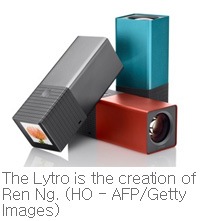 Lytro’s role in photojournalism: A novelty or a new path?
Lytro’s role in photojournalism: A novelty or a new path?
After the highly anticipated release of the Lytro, The Washington Post photo department put the camera in the hands of our photographers. The general consensus? Lots of potential, but purely a novelty in its current state.
The Lytro is a camera that can record the direction of light rays, enabling a photo to be refocused after it is shot. The half pound camera, which acts something like a kaleidoscope, made a big splash before the buzz quickly dissipated. Was it because after clicking around a few of these photos, the novelty wore off? Is there a future for the Lytro?
First of all, the Lytro can be seen in two ways: as a creative tool or as a crutch. For sure, the average consumer may be interested since the Lytro could rescue photographs that are slightly out of focus.
The Lytro is the creation of Ren Ng. (HO - AFP/Getty Images) On the other hand, there is always a danger to the “fix it in post” mantra. If a serious photographer shoots to fix and crop, will a sharp mind and specific artistic style that great photography requires fully develop? Post photographer Bill O’Leary argues that refocusing could become just another instrument in a photographer’s toolkit.
O’Leary said, “One old pro had this to say at the time: ‘Autofocus is going to make bums out of photographers and photographers out of bums.’ So all the technical skills that we needed years to learn are now automatic … these refinements aren’t much help with the composition and conceptualization. Future photographers can now spend more time using the right side of their brains to produce better images.”
When posed the question of whether the technology is specifically ethically viable in the newsroom, Washington Post director of photography Michel du Cille stated, “Absolutely not, unless used in a photo illustration.” Drastically modifying a photo after the fact is unethical in photojournalism.
To address the Lytro as a creative tool, we have to ask, “What is a good picture?” The answer to this is not only highly subjective, but also changes depending on format, audience and context.
For the Lytro, a good photo is one that incorporates what Lytro’s director of photography Eric Cheng refers to as a “reveal.” In fact, from a shooting standpoint, a photographer will have to learn to see all possible photos that that can result from a single frame with different focuses. In a great Lytro photo, all those possibilities would have to be compelling and meaningful in different ways.
Toni Footer with a photo of her late father for our story on long-term health-care insurance. (Bill O'Leary - The Washington Post) O’Leary said there were photos he had taken in the past where Lytro technology would have enhanced his photos. In the photo at left, O’Leary had to open the aperture because of the low-light situation, but had a resulting shallow depth of field, preventing him from getting both the woman and her father in focus.
In the future, I will be eager to see whether it is possible to harness the potential of the Lytro’s creativity, and to see future iterations of the tool.
Have you seen any great Lytro photos surface? Share your links in the comments.
 Lytro’s role in photojournalism: A novelty or a new path?
Lytro’s role in photojournalism: A novelty or a new path?